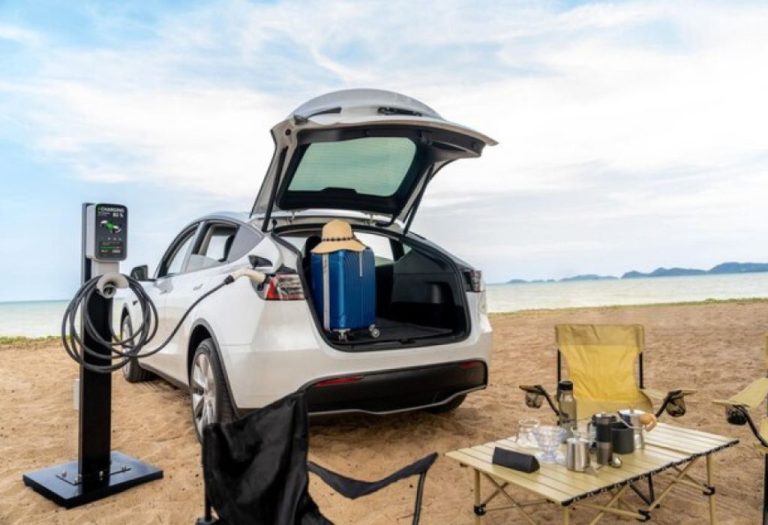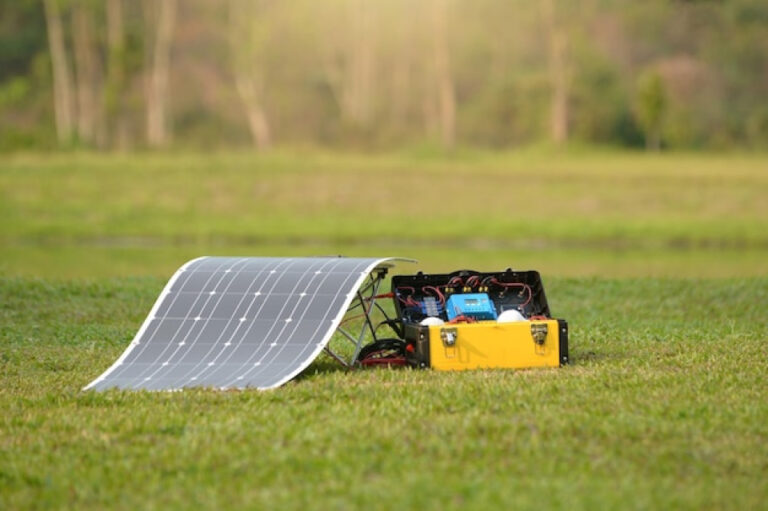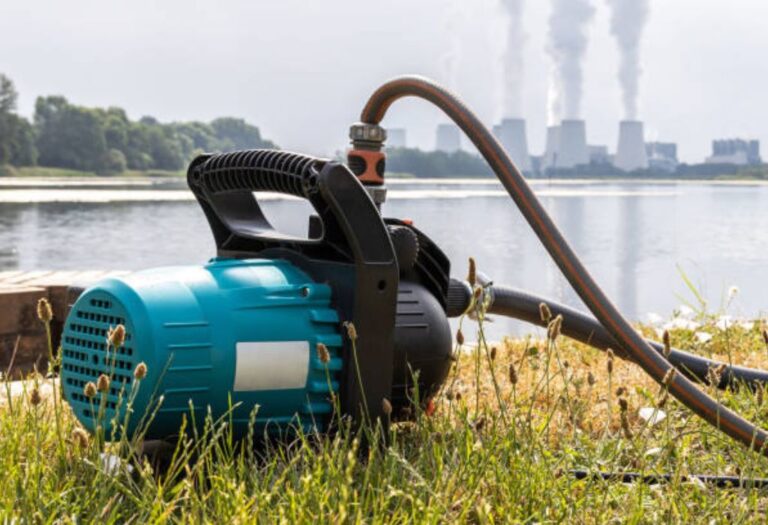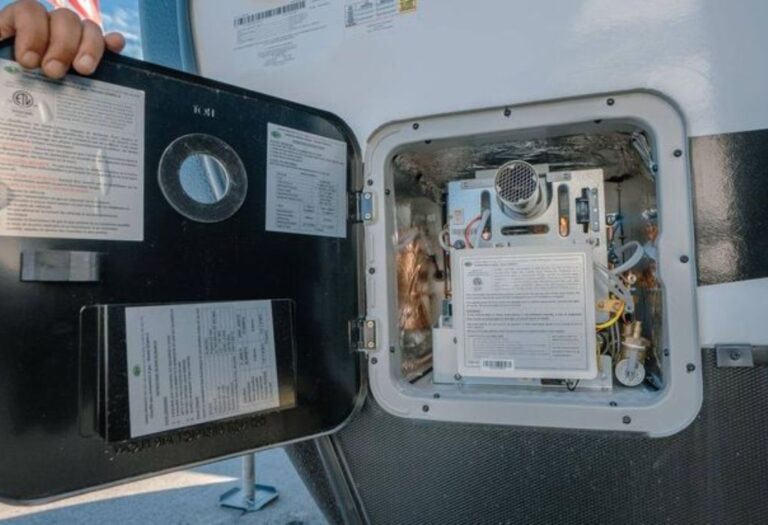How Long for RV Water Pump to Build Pressure?
The campsite is quiet until a faucet opens and the pump hums to life. Curiosity spikes as the mind asks how long for RV water pump to build pressure before steady water arrives.
Timing hinges on system state. A primed system pressurizes quickly, while first start after storage takes longer as air purges and the water heater fills.
Most RV diaphragm pumps are self-priming, designed to move air and water until flow stabilizes. A common model spec lists self-priming up to 6 ft (1.8 m) of lift, which helps clear lines after refills (SHURflo 4008 datasheet).
Shut-off happens when the pressure switch reaches its target range. Many RV pumps are calibrated around 40–55 PSI, where the motor stops until demand returns.
Normal behavior is fast once primed. First runs after de-winterizing can take a minute or two as both hot and cold lines purge and the heater tank fills.
Variables stretch the clock. Air locks, a closed water-heater bypass, a clogged strainer, suction-side air leaks, or low 12V voltage all slow pressure build and cause sputtering.
A quick checklist solves most delays. Opening the farthest faucet, then the hot side, speeds air removal while the pump reaches shut-off smoothly.
This guide shows clear timeframes and the exact steps that shorten them. It also explains pressure switches, accumulator tanks, and check valves in simple terms.
Readers get a fast diagnostic path that avoids guesswork. The goal is reliable, quiet pressurization every time the switch flips.
Quick Answer: how long for RV water pump to build pressure

A healthy, primed system usually reaches shut-off in 3–10 seconds and the pump stops. After de-winterizing or a full drain, expect 30–120 seconds while air purges and the water heater fills (SHURflo 4008 • SEAFLO 33-Series).
Self-priming diaphragm pumps move air and water until the pressure switch hits its target, often 40–55 PSI, then remain off until a faucet opens again (SEAFLO • SHURflo).
What’s “normal” when primed?
A few seconds to reach shut-off, then silence.
Why can first start take a minute or two?
Lines and the heater tank must fill while trapped air escapes.
Pump runs continuously with all taps closed, problem?
Yes, check for leaks, air locks, a clogged strainer, or a mis-set pressure switch.
Does an accumulator change the time?
It smooths the last seconds and reduces cycling but does not replace proper priming.
City water connection affect build time?
A stuck check valve at the city inlet can block pressure rise until cleaned or replaced.
What “building pressure” means in RV systems
On-demand diaphragm pumps pressurize the plumbing to a shut-off PSI, then stop. When a faucet opens and pressure drops to the cut-in point, the switch restarts the pump to recover pressure (SEAFLO).
Self-priming helps push air out of lines, yet large pockets or restrictions can slow pressurization. Manuals describe purge steps that clear air quickly (SHURflo).
What is shut-off pressure?
The PSI where the pressure switch stops the motor.
What is cut-in pressure?
The lower PSI that restarts the pump when a tap opens.
Why does sputtering happen at faucets?
Air pockets are leaving the lines and water heater.
Is GPM related to build time?
Higher flow can purge air faster if voltage and lines are clear.
Can the pump be damaged by short cycling?
Rapid cycling causes heat and noise, which an accumulator can reduce.
First-run after storage or winterizing
Expect longer priming as the heater and lines fill for the first day. Open a cold and hot faucet to purge air, then verify the water-heater bypass is set to normal service (typical de-winterize steps).
Low-point drains and outdoor shower valves must be closed or the system will chase a leak forever. Watch the strainer for bubbles that indicate suction-side air entry.
Open hot or cold first?
Open both briefly; hot side vents the heater fast.
Heater bypass wrong, what happens?
The tank may not fill or pressure will stall.
How long is reasonable on first fill?
Up to a couple of minutes while air exits the lines.
Need to cycle the pump switch?
Steady running is fine until faucets stop sputtering.
Should low-point drains be checked?
Yes, open drains prevent pressure buildup.
Troubleshooting slow or no pressure
Start with 12V power at the pump while running. Voltage sag below the pump’s rating extends build time and weakens flow (SEAFLO).
Clean the inlet strainer, confirm the pickup tube sits in water, and tighten suction fittings to stop air ingestion. Inspect the city water check valve and the pump’s internal check valves if the pump never shuts off (brand troubleshooting charts).
Pump runs but no water at taps?
Prime the pump and check suction valves for closures or leaks.
Pump won’t shut off with fixtures closed?
Look for leaks, mis-adjusted switch, or a stuck check valve.
Weak flow plus long build time?
Clogged strainer or low voltage under load is common.
Lines gurgle forever?
Purge at the farthest faucet and bleed the heater.
New pump same problem?
Valve positions or restrictions in the system are likely.
Priming and purging, fastest procedure
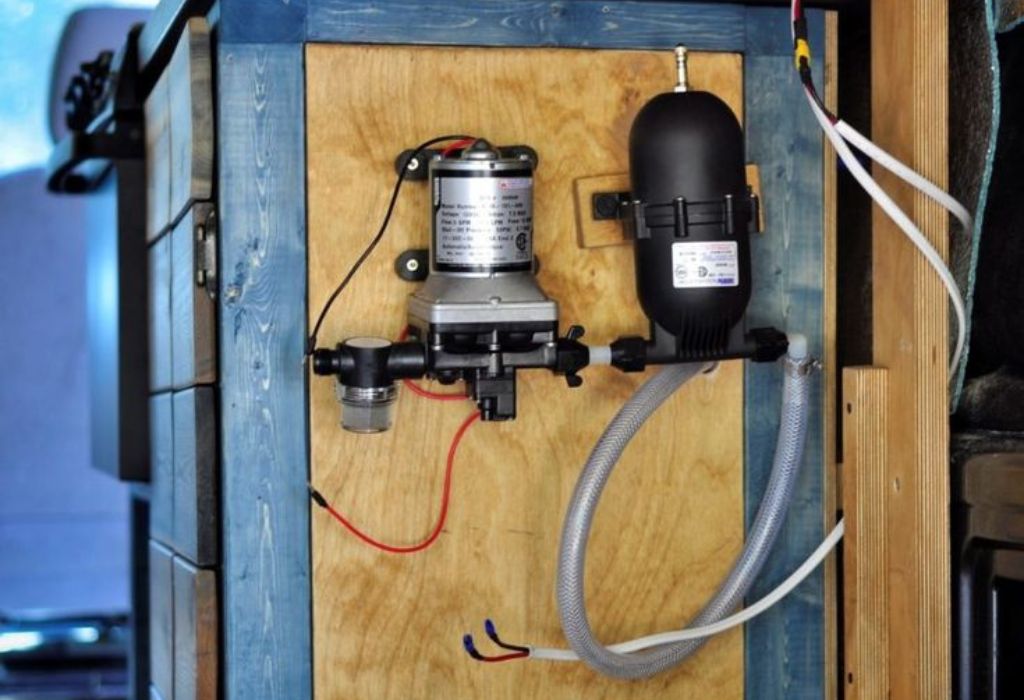
Fill the fresh tank and set the control panel to normal service. Open the farthest cold tap and run the pump until sputtering stops, then repeat on the hot side to fill the heater (SHURflo setup).
Close taps and confirm the pump stops within seconds. If not, purge again at high fixtures and recheck valves for bypass settings.
Do you need to pre-fill the pump head?
No, most RV pumps are self-priming within lift limits.
Best way to purge air quickly?
Open multiple taps to move volume at once.
Water heater considerations?
Verify bypass and relieve air at a hot tap or relief valve.
Strainer location matter?
Yes, keep it on the inlet and free of debris for best priming.
Sanitizing affect time?
Residual sanitizer can foam and delay purge.
Pressure switch basics and adjustment
The pressure switch controls shut-off and restart PSI. Some models allow minor adjustment, which should be a last step after air and leak checks (SEAFLO • SHURflo).
Turning the set screw changes shut-off PSI and can worsen long run times if mis-set. When in doubt, return to factory settings or replace the switch.
When to adjust the switch?
Only after leaks, strainer, and voltage have been verified.
Which direction lowers shut-off PSI?
Many switches reduce PSI counter-clockwise, but confirm your manual.
Can a bad switch mimic air issues?
Yes, it can prevent shut-off even when pressure is present.
What about built-in bypass valves?
Mis-adjustment can cause constant running and poor stabilization.
Replace or rebuild?
Use manufacturer kits or swap the assembly if troubleshooting fails.
Accumulator tanks and cycling
An accumulator stores a small cushion of water and air to smooth pressure. It helps reduce rapid on-off cycling once pressure is reached.
Correct pre-charge set near cut-in PSI keeps the pump off longer between uses. It does not replace priming, but it improves stability and noise.
Does an accumulator shorten build time?
It mainly smooths the last seconds and reduces chatter.
What pre-charge should be used?
Match the pump’s cut-in PSI per tank instructions.
Can a water-logged tank cause issues?
Yes, it forces short cycling and unstable flow.
Is an accumulator required?
No, but many owners find it a worthwhile upgrade.
Any maintenance needed?
Check air charge each season and after storage.
Maintenance that keeps pressurization fast
Keep the strainer clear, fittings tight, and suction hose free from kinks or collapse. Flexible lines reduce cavitation and noise.
Inspect and clean the city water check valve yearly, which often sticks after storage. Follow the maker’s sanitizing and winterizing steps to prevent foaming and debris (SHURflo).
How often to clean the strainer?
Before trips and after tank refills or boondocking.
Do old hoses affect time?
A collapsed suction hose starves the pump.
Lube or service intervals?
Follow the pump manual for diaphragm and check-valve care.
Does winterizing mode change behavior?
Yes, bypass settings can block suction or the heater fill path.
Should the pump run dry?
Avoid extended dry running and keep the tank level above the pickup.
When to suspect a faulty pump
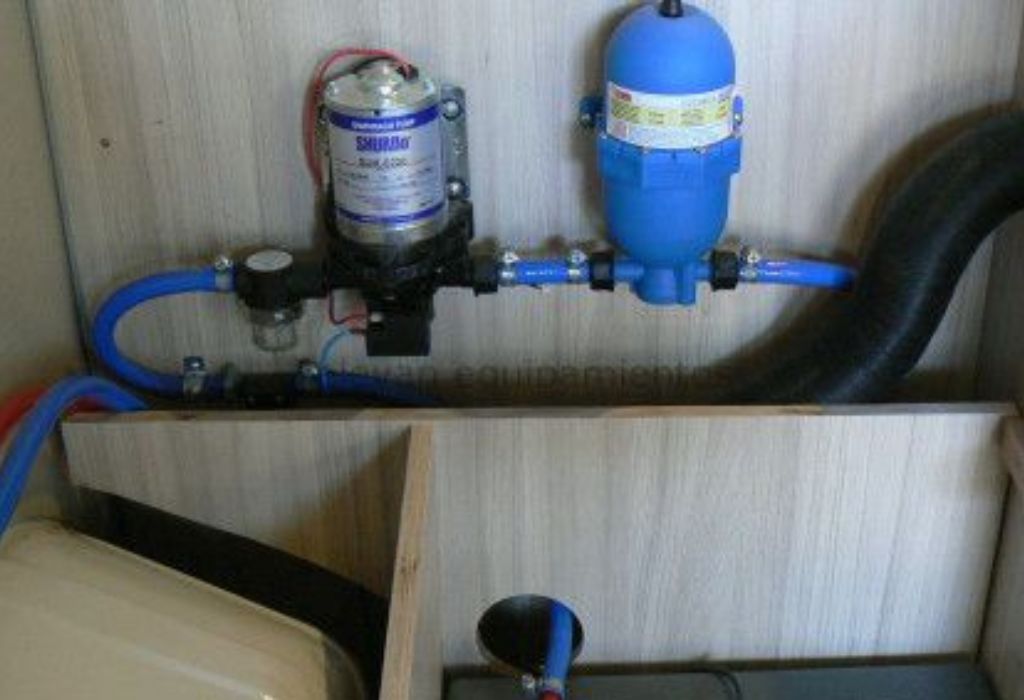
If voltage is correct, valves are set, and lines are purged yet pressure never arrives, internal check valves or the diaphragm may be worn. Brand manuals include step-by-step trees for these symptoms (SHURflo troubleshooting).
Persistent stall, overheating, or leaking heads are signs to rebuild or replace. Match GPM and PSI ratings to the RV’s plumbing layout.
Classic signs of failure?
Constant running, no shut-off, and poor flow with clear lines.
Rebuild kit or new unit?
Economics, availability, and time decide the path.
Will upsizing help?
Only if long runs and multiple fixtures demand more flow.
Are brand manuals helpful?
Yes, they list tests for switches, bypass, and check valves.
Keep the old pump as a spare?
Yes if it can be rebuilt and passes a leak test.
Real-world scenarios
After de-winterizing
Purge all faucets hot and cold until sputter ends, confirm heater bypass, and expect up to 2 minutes to stabilize on day one (typical steps).
Mid-trip tank refill
Primed systems recover in seconds. Long delays point to air leaks or a clogged strainer.
New pump install
Follow priming steps and verify every panel valve. If it never shuts off, check switch set point and check-valve seating.
Open multiple faucets or one?
Open the farthest first, then others for faster purge.
Why hot side first on some rigs?
It vents the heater tank quickly and prevents vapor locks.
Normal run sound vs cavitation?
Cavitation sounds harsher and includes surging or rattling.
Use city water to help prime?
Briefly pressurize to seat check valves and push air out of high points.
How long before calling it a problem?
If still not building after a couple of minutes with correct setup, begin the checklist.
Conclusion
The practical answer to how long for RV water pump to build pressure is seconds when primed, and up to a couple of minutes after drains, storage, or service while air and the water heater are cleared (SEAFLO • SHURflo).
If the pump runs much longer, verify valve positions, purge at the farthest faucet, clean the strainer, confirm voltage, and review the pressure switch and check valves with the brand’s guide. A short, methodical routine restores quick, quiet pressure every time.
Final Q&A
Normal time when primed?
Seconds to reach cut-off and silence.
After storage?
Up to 2 minutes while the heater and lines fill.
Won’t shut off at all?
Leak, switch, or check-valve issue needs attention.
Fastest on-site fix?
Purge hot and cold at the farthest fixture and recheck bypass.
Best prevention?
Seasonal strainer cleaning, valve verification, and solid 12V power to the pump.
I’m David R. Coleman, the founder, lead writer, and lifelong tool enthusiast behind GarageToolPro.com. With years of experience in automotive repair, woodworking, and home DIY projects, I created this platform to share practical tips, detailed tool reviews, and step-by-step guides that help mechanics, hobbyists, and homeowners get the job done right the first time.

